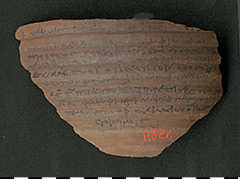O.Wilck. 1224 (P. 321)
Egypt’s wealth relied on the annual flooding of the Nile and its fertile riverbanks; hence, the land was considered the granary of the ancient world. The ancient Egyptians also possessed excellent irrigation systems, further augmenting their prosperity. The following artifact provides insight into the economic organization of grain cultivation.
It is a piece of pottery with writing, an ostracon. Ostraca allow us a better understanding of the daily life of the ancient population. They served as a kind of „ancient scratch paper“ for notes, schoolwork, accounts, receipts, and various short letters.
This ostracon was acquired on March 30, 1859, by the German Egyptologist Heinrich Brugsch in Thebes through a purchase. Brugsch is considered one of the greatest Egyptologists of the 19th century.
It is inscribed with ten lines of Greek text. The text can be dated to October 17, 695 AD. It was written during the time after the Arab conquest of Egypt in 641 AD. The text does not explicitly mention a specific date. Instead, it is dated to the 19th Phaophi of the 9th indiction. Phaophi is an Egyptian month name, with the 19th Phaophi corresponding to October 17th. Unfortunately, the 9th indiction cannot be easily converted into our current dating system. The indiction was a dating system established in the 4th century AD for counting tax years. It had a 15-year cycle and was simply numbered. In the text under discussion here, the 9th year of this cycle is indicated. For the people of that time, it was clear in which year they lived. For us today, conversion without further dating clues is difficult – there were too many 9th indictions. However, the text provides us with a clue. The Pekysios mentioned in the text is also known from other texts that can be dated more precisely. Thus, we can also assign the indiction year and date the text to the year 695 AD.
Regarding Pekysios, we learn that he was a protokometes (a kind of village elder) in the fortress of Memnoneia on the western bank of the Nile opposite Thebes. In the text on the ostracon, he instructs a Josephios, in this capacity, to cultivate leased land, even though it is dried out and overgrown with reeds. The basis for the fertility of ancient Egypt and its status as the granary of the ancient world were the annual floods of the Nile, which brought the nutrient-rich mud that gave the soil its fertility. However, the floods did not always reach all fields or were too low. To counter these unpredictable risks, an extensive irrigation system with canals, waterwheels, etc., was established. Such irrigation devices are also referenced in our text. Josephios is to cultivate the farmland using an irrigation apparatus belonging to a Pouar. With due caution, one can infer that this person’s family was of some importance in this area. Pouar is mentioned again at the end of the text, as the father of a Paulos. He apparently preceded Pekysios as protokometes and probably had a similar agreement with Josephios for the cultivation of the farmland, which is only referred to here.
Unfortunately, we do not learn which plants Josephios cultivated on this farmland. Presumably, however, it was grain. Nevertheless, the text also refers to the lease contract, through which Josephios could cultivate this farmland at all. Through it, he agreed to pay one-third of the yields as rent. This amounts to 1/6 of a gold nomisma, a currency used at that time.
This text not only provides insight into the lives of ordinary people and the administrative structures of ancient Egypt but is also a significant proof that even under Arab rule, other languages such as Greek were used in important administrative institutions and thus continued to exist.



